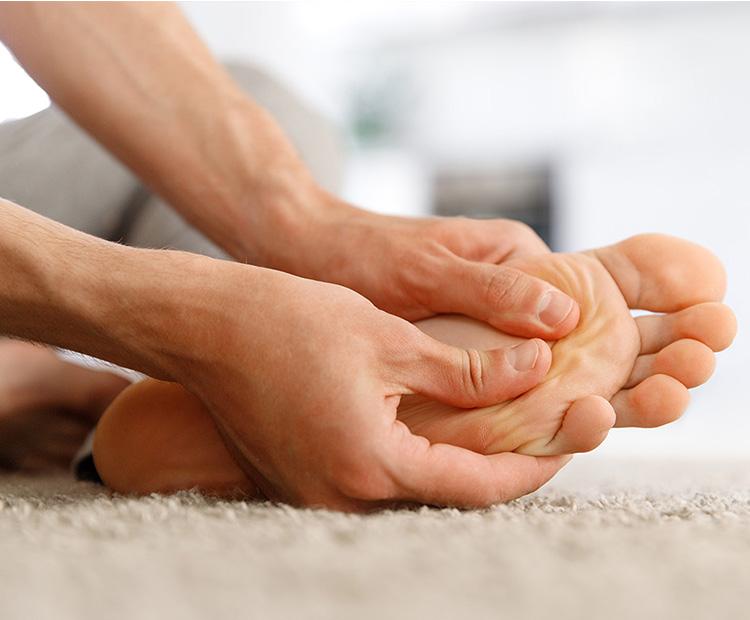What is the Best Treatment for Diabetic Neuropathy in feet?
Neuropathy is a condition that damages nerves in the body. When these nerves are affected, individuals with this condition may experience symptoms such as numbness, tingling, and pain. These symptoms are frequently felt in the extremities, especially the feet.
Although various conditions can lead to neuropathy, diabetes is one of the most common causes. According to the National Institute of Diabetes and Digestive and Kidney Diseases, research indicates that up to about 50% of people with diabetes develop peripheral neuropathy1.
The guide below provides information on diabetic neuropathy, especially how it affects the feet, along with treatment options.
What is Diabetic Neuropathy?
Diabetic neuropathy is a type of nerve damage that can result from prolonged high blood sugar levels. It can occur in people with both type 1 and type 2 diabetes.
Nerves, or the bundles of tissue that carry signals between the brain and different areas of the body, send signals that allow the perception of touch, the movement of body parts, and the control of various bodily functions, including digestion.
When the nerves become damaged due to diabetes, symptoms such as an affected sense of touch, weakness, and pain may occur. Although these symptoms can be felt in many places, they are most common in the feet.
Types of Diabetic Neuropathy
There are different types of diabetic neuropathy based on the nerves involved. The types of diabetes-related neuropathy include the following:
Peripheral Neuropathy
Peripheral neuropathy, the most common type of disease-related neuropathy2, involves damage to the nerves outside of the spinal cord. It typically affects the feet, legs, and hands.
Autonomic Neuropathy
Autonomic neuropathy involves damage to the autonomic nerves, which control internal organs. These nerves control involuntary body processes and affect the digestive tract, blood pressure, and heart rate. When the nerves become damaged, they can cause problems with body parts such as the sex organs, urinary tract, and sweat glands.
Proximal Neuropathy
Proximal neuropathy is a rare form of diabetes-related neuropathy that leads to nerve damage in the thigh, hip, or buttocks. It usually only affects one side of the body.
Focal Neuropathy
Focal neuropathy involves damage to a single nerve in the hand, head, or leg. It is less common than peripheral or autonomic neuropathy.
Symptoms of Diabetic Neuropathy
Symptoms of diabetic neuropathy may vary depending on the type of neuropathy and the severity of nerve damage. For example, individuals may not notice symptoms of mild nerve damage for several years. In other instances, diabetic nerve pain may involve severe pain that comes on suddenly.
Possible nerve pain symptoms include:
- Pain in the legs, feet, or hands, which may include a burning feeling or stabbing pain
- Chronic pain
- Decreased muscle strength
- Numbness, tingling, or a pins and needles sensation
- Complete loss of sensation in the feet
- Cardiovascular symptoms which may include low blood pressure
- Sexual dysfunction, which may include vaginal dryness
- Excessive sweating or a lack of sweating
- Urinary incontinence or retention
- Slow-healing foot or leg sores
What Causes Diabetic Neuropathy?
Diabetic neuropathy may be a result of a diabetes complication. Over time, diabetes and high blood glucose levels may damage nerves or the blood vessels that carry oxygen and nutrients, preventing nerves from functioning properly.
How is Diabetic Neuropathy Diagnosed?
Diabetic neuropathy is typically diagnosed through a combination of medical history, physical exam, and electrodiagnostic testing. The diagnostic process generally starts with a detailed medical history, a review of symptoms, and a physical exam. If peripheral neuropathy is suspected, a medical exam will also include an assessment of the feet.
Once the first two parts of the exam are completed, the next step may be diagnostic testing. There are two types of electrodiagnostic testing: nerve conduction studies, which measure how fast electrical signals travel through your peripheral nerves, and electromyography, which evaluates the health of your skeletal muscles and the nerves to those muscles.
What is the Best Treatment for Diabetic Neuropathy in the Feet?
Treatment options for neuropathy in the feet, the most common diabetes-related neuropathy, focus on reducing symptoms and preventing the condition from worsening.
Good diabetes management is one way to reduce the risk of developing diabetic neuropathy in the feet. This can include keeping blood sugar levels in a target range. However, certain factors can affect your blood sugar level, including increased stress, eating more than usual, and being sick.
Managing diabetes also includes managing other symptoms that can make diabetes worse, such as high blood pressure and cholesterol levels. Individuals with diabetes should work closely with their healthcare provider to develop a management plan that keeps blood sugar levels healthy.
Medications
Medication can play an important role in diabetic pain management. Medications may help ease chronic pain, restore function, and reduce the risk of further complications.
The FDA has approved certain medications to treat diabetic neuropathy. However, healthcare professionals may use some off-label medicines that are FDA-approved to treat a different condition to treat neuropathic pain.
Medications used for neuropathy include:
- Lyrica (pregabalin): This medication inhibits the neurotransmitter GABA, which is associated with nerve pain. While the exact mechanism isn’t fully understood, Lyrica is a first-line treatment for diabetic neuropathy.
- Cymbalta (duloxetine): Cymbalta is an FDA-approved antidepressant for treating pain from diabetes-related neuropathy. It works on the central nervous system to help block pain signals.
- Capsaicin: This compound may be used as a topical to reduce foot pain associated with peripheral neuropathy by potentially desensitizing pain nerve signals in the skin.
Physical Therapy
Physical therapy can benefit people with peripheral neuropathy, especially those experiencing balance issues and muscle weakness. It may include exercises to improve strength and balance or techniques like vibration training to stimulate blood flow to the feet. Both options can have a positive impact on neuropathy.
Although studies on the effectiveness of physical therapy for peripheral neuropathy are limited, therapy is generally safe and may provide benefits without worsening symptoms.
Spinal Cord Stimulation
Spinal cord stimulation is another option for some people with peripheral neuropathy. It involves implanting a device that delivers low-level electrical pulses to the spinal cord to help alleviate neuropathic pain.
Various studies indicate that spinal cord stimulation can significantly reduce discomfort in people with nerve pain. For instance, a study published in JAMA Neurology4 involving 216 randomized patients found that spinal cord stimulation provided substantial pain relief and improved the quality of life of an individual experiencing neuropathy.
Can You Prevent Diabetic Neuropathy?
Although diabetic neuropathy is common, it is important to understand that not everyone with diabetes develops diabetic neuropathy. In fact, there are many ways individuals with diabetes can decrease their risk of developing diabetes-related neuropathy, including the following:
- Maintaining an A1C under 7%
- Following a healthy meal and exercise plan
- Maintaining a healthy weight
- Avoiding or quitting smoking
- Visiting your doctor at least yearly for a foot exam
- Limiting alcohol
It is important to regularly check your feet for wounds, broken skin, or blisters. People with diabetic neuropathy may not feel sores or blisters, and these unnoticed wounds can lead to infections.
It is also crucial to identify symptoms of neuropathy as soon as possible. Diagnosing diabetic neuropathy in its early stage may be key to preventing complications and allowing the condition to become worse.
Summary
If you have symptoms of diabetic neuropathy, there are treatments available. If you would like more information on treatment options for diabetic neuropathy or are interested in spinal cord stimulation, we are happy to answer your questions. To schedule an appointment, please contact Advanced Spine and Pain today!
Schedule an appointment online or contact us at 480-573-0130.
References
- What is Diabetic Neuropathy? (2018). The National Institute of Diabetes, and Digestive and Kidney Diseases. https://www.niddk.nih.gov/health-information/diabetes/overview/preventing-problems/nerve-damage-diabetic-neuropathies/what-is-diabetic-neuropathy
- Diabetic Neuropathy Overview. (n.d.). Mayo Clinic. https://www.mayoclinic.org/diseases-conditions/diabetic-neuropathy/symptoms-causes/syc-20371580
- Focal Neuropathies. (2018). The National Institute of Diabetes, and Digestive and Kidney Diseases. https://www.niddk.nih.gov/health-information/diabetes/overview/preventing-problems/nerve-damage-diabetic-neuropathies/focal-neuropathies
- Petersen, E. A., Stauss, T. G., Scowcroft, J. A., Brooks, E. S., White, J. L., Sills, S. M., ... & Mekhail, N. A. (2021). Effect of high-frequency (10-kHz) spinal cord stimulation in patients with painful diabetic neuropathy: a randomized clinical trial. JAMA neurology, 78(6), 687-698.https://jamanetwork.com/journals/jamaneurology/fullarticle/2777806#google_vignette

